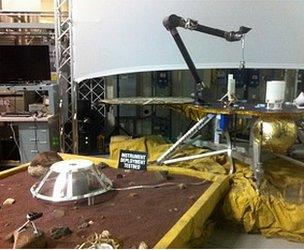Nasa's new Mars mission: A Phoenix rising
- Published
We were told on Sunday that Nasa would announce the decision I'd been waiting to hear for two years.
Did we have a mission to Mars? If the answer was yes, my life for the next four years was overbooked: we had a seismic sensor to make and I was moving into a house that was being engulfed by creepers.
Whatever mission Nasa chose, the house needed some attention.
The immediate course of action was obvious: I climbed a ladder to clear away the foliage. Under the eaves was an old insurance plaque: the company, Phoenix.
Four years ago I was working in Arizona at the Science Operations Center of a Martian mission. In contrast to the heat outside, our spacecraft Phoenix was in the Martian arctic, where the temperature reached -5C on a good day, and we were looking for ice.
We found the ice four years ago, thanks to a robot arm that scraped below the surface. Since then I've been working on both analysing the data we returned from Phoenix and preparing a proposal for the next chance to send new instruments to Mars in 2016.
The images we got back from our microscopes indicated that the soil we saw had not been wetted by the melting of that ice. It was difficult to see how any life could maintain a foothold, external in such an arid environment.
We now wanted a chance to look back much further, to understand how young Mars had evolved, and how its path had diverged so far from Earth's. To do that we needed to look at Mars' interior and compare its layering to Earth's concentric shells of crust, mantle and liquid outer core wrapped round a solid kernel.
There's plenty of room for speculation as to whether an early Martian magnetic field collapsed as the core completely solidified, allowing the primordial atmosphere to be stripped away by the solar wind. Was there ever plate tectonics as on Earth?

InSight would listen to the internal workings of the Red Planet, including any marsquakes
For our planet, this is a vital part of the long-term carbon cycle, burying the carbonates from shellfish and then releasing carbon dioxide in volcanic eruptions.
While Nasa's latest rover Curiosity is looking at the oldest rock formations, we want to look at signs that tell us about the earliest processes of Mars. Our proposed mission InSight had assembled an international team to produce a seismic system to listen to the internal workings of the planet.
Each marsquake we sensed would tell us a little more about the layering of the planet. Imperial's part, with our collaborators at Oxford, was to provide a seismometer fabricated from silicon to measure the vibrations of the planet.

The payload underwent deployment testing at JPL in California
We'd been working on this even through the Phoenix mission. I'd taken a break from mission operations to test our seismometer in California and we'd outperformed any other silicon sensor. We were included as part of the InSight payload, one of 28 proposals submitted to Nasa in 2010.
Last year we made the cut to the final three. The other two proposals were the Titan Mare Explorer (TiME) and the Comet Hopper (CHopper). Back in May, our final review in Pasadena had gone better than we could have hoped: we even got a round of applause from Nasa's review board.
Now I was up a ladder, hoping that the fire insurance plaque was a sign. Phoenix as a mission was dead, crushed by the ice that descended at the end of the Martian summer. But the Phoenix lander could rise again from Earth.
Our payload would be on a copy of that spacecraft, with the robot arm given a new task, to carefully place our seismic station on the surface of Mars. And there would be no ice just below the surface this time - the Phoenix would land at the equator to catch enough solar energy to drive our mission for two years.
On Monday evening we hear: Phoenix has indeed arisen, but now as InSight. We're going back to Mars.
- Published20 August 2012